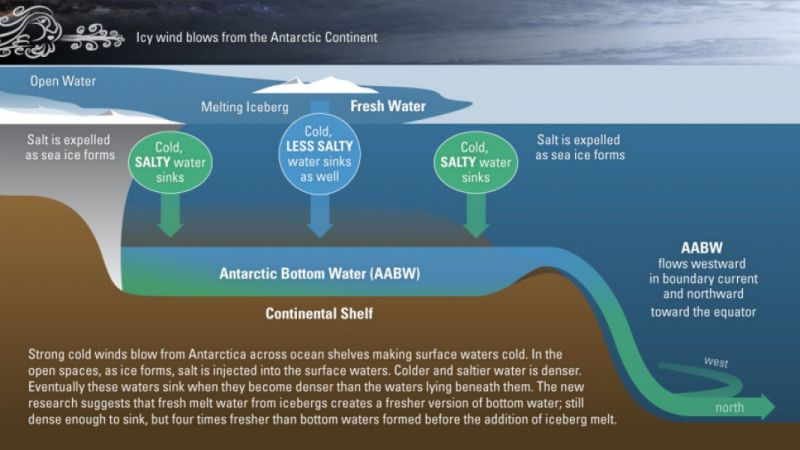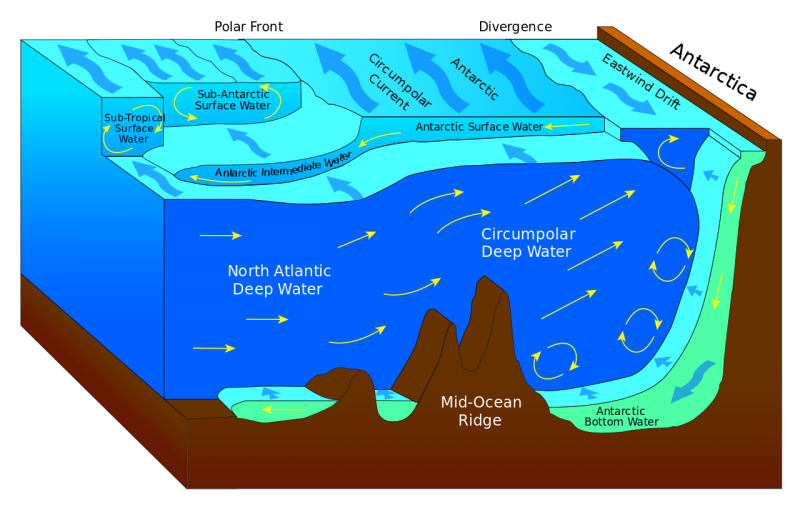Antarctic Bottom Waters Freshening at Unexpected Rate
Published on by Water Network Research, Official research team of The Water Network in Academic
A team led by WHOI oceanographers report that Antarctic Bottom Water has freshened at a surprising rate between 2007 and 2016 - a shift that could alter ocean circulation and contribute to rising sea levels.

In some places along the Antarctic coast, ice formation causes seawater to grow saltier and therefore denser, so that it sinks to the sea floor. Known as the Antarctic Bottom Waters (AABW), these deep, cold waters play a critical role in regulating circulation, temperature, and availability of oxygen and nutrients throughout the world's oceans; Credit: Eric Taylor, Woods Hole Oceanographic Institution
The team is lead by WHOI oceanographers Viviane Menezes and Alison Macdonald.
"If you change the circulation, you change everything in the ocean," said Menezes, a WHOI postdoctoral investigator and the study's lead author. Ocean circulation drives the movement of warm and cold waters around the world, so it is essential to storing and regulating heat and plays a key role in Earth's temperature and climate. "But we don't have the whole story yet. We have some new pieces, but we don't have the entire puzzle."
The puzzle itself isn't new: past studies suggest that AABW has been undergoing significant changes for decades. Since the 1990s, an international program of repeat surveys has periodically sampled certain ocean basins around the world to track the circulation and conditions at these spots over time.
Along one string of sites, or "stations," that stretches from Antarctica to the southern Indian Ocean, researchers have tracked the conditions of AABW -- a layer of profoundly cold water less than 0°C (it stays liquid because of its salt content, or salinity) that moves through the abyssal ocean, mixing with warmer waters as it circulates around the globe in the Southern Ocean and northward into all three of the major ocean basins.
 The AABW forms along the Antarctic ice shelves, where strong winds cool open areas of water, called polynyas, until some of the water freezes. The salt in the water doesn't freeze, however, so the unfrozen seawater around the ice becomes saltier. The salt makes the water denser, causing it to sink to the ocean bottom.
The AABW forms along the Antarctic ice shelves, where strong winds cool open areas of water, called polynyas, until some of the water freezes. The salt in the water doesn't freeze, however, so the unfrozen seawater around the ice becomes saltier. The salt makes the water denser, causing it to sink to the ocean bottom.
"These waters are thought to be the underpinning of the large-scale global ocean circulation," said Macdonald, a WHOI senior research specialist and the study's co-author. "Antarctic Bottom Water gets its characteristics from the atmosphere -- for example, dissolved carbon and oxygen -- and sends them deep into the ocean. Then, as the water moves around the globe, it mixes with the water around it and they start to share each other's properties. It's like taking a deep breath and letting it go really slowly, over decades or even centuries."
As a result, the frigid flow plays a critical role in regulating circulation, temperature, and availability of oxygen and nutrients throughout the world's oceans, and serves as both a barometer for climate change and a factor that can contribute to that change.
A past study using the repeat survey data found that AABW had warmed and freshened (grown less saline) between 1994 and 2007. When Macdonald and Menezes revisited the line of stations, they measured how AABW has changed in the years since.
"The fresher and warmer the water is, the less dense it will be, and the more it will expand and take up more space -- and that leads to rising sea levels," Macdonald said. "If these waters no longer sink, it could have far reaching affects for global ocean circulation patterns."
Questions remain around the cause of the shift. Menezes and Macdonald hypothesize that the freshening could be due to a recent landscape-changing event. Future studies could use chemical analysis to trace the waters back to the site of the collision and calving and confirm the hypothesis.
Read more on: Science Daily
Media
Taxonomy
- Marine
- Freshwater
- Oceanographic Survey
- Sea Level Rise Vulnerability Assesment
- Academic Study